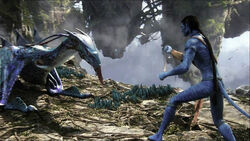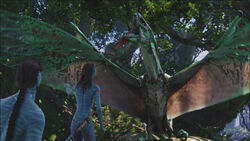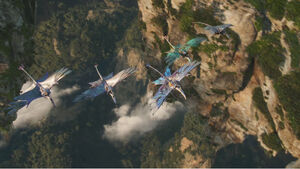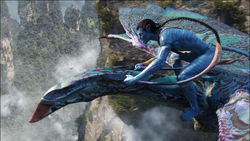Mountain banshees (Na'vi name: ikran) are large, bird-like aerial predators that are native to Pandora. They are used by the Na'vi for hunting from the air and traveling larger distances. Ikran are also used in battle, where the mount attacks its opponents from the air.
In Na'vi Culture
Bonding with a banshee and becoming an Ikran Makto is a dangerous and required rite of passage for Na'vi warriors in some clans, including the Omaticaya. Like the direhorse, a Na'vi can connect to a banshee through a neural interface that allows animal and rider to move with apparent effortlessness through the skies. Unlike the direhorse, however, the banshee will only bond with one Na'vi in its lifetime. It is unknown whether the banshee or its rider can bond with a new partner should the previous one die, as is the case with Neytiri's mount Seze having been killed during the Assault on the Tree of Souls.

In Na'vi culture, taming a banshee is a test every young hunter has to pass.
The mountain banshee rookery is high in the Hallelujah Mountains. The largest rookery, which features the largest specimens (and therefore the best to tame for riding), is in grottoes and outcrops on the sheer cliff faces of Mons Veritatis, one of the largest of the floating mountains. It is here that the Na'vi come to select (and be selected by) a banshee for domestication. The bonded mountain banshees nest in the highest branches of Hometree, where they can be close at hand for their Na'vi rider.
The mountain banshee (like its smaller cousin, the forest banshee) is highly adapted for flight. Specially developed muscles attached to the breastbone allow for the powerful strokes needed to achieve lift. Xenobiologists continue to study the aerodynamics of the banshee. It is believed that all of Pandora's flying animals take advantage of gravity that is lower than Earth's and the increased air density, (which requires more force to displace with the downward/rearward stroke of their wings, and thus gives the animal's body more impetus with each flap). The downside is that the denser air is harder to move through, and requires highly-efficient streamlining to achieve high flight speeds.
Biology
Though reptilian in appearance, the banshee has a metabolism that is bird-like, and generates tremendous heat. The banshee has a complex cooling system to keep it from overheating during strenuous flying. The breathing system is central to this cooling. The air inlets, or spiracles, face forward at the front of the chest cavity, like the engine intakes of a jet fighter. Induction of air is controlled by a cartilaginous operculum, or flap-valve. The banshee lung is a bellows like structure, inflated by rib movement, but unlike the lungs of terrestrial animals, it has unidirectional flow, venting aft through gill-like slits.

Neytiri pets Seze, her ikran
The banshee has two primary eyes which see in full color in roughly the same spectrum as human vision. Aft of the primary eyes are smaller secondary eyes, which can move independently or together with the primaries. They see in near infrared, for night hunting. Additionally, banshees are also highly sensitive to motion, and act as an early warning system against attack from the rear. All four eyes are protected by lids and by transparent nictating membranes, much like an eagle eye. Forward of the primary eyes are lines of sensor pits. These are thought to provide airflow information in flight, like a pitot tube on an airplane. Another hypothesis is that they are sensitive to sound, and have an echolocation role, by sensing the reflected sound of the banshee shrieks. It is advised to never look directly into an ikran's eyes, though it is not explained what happens if you do. Most likely, it induces panic or anger in the ikran.
Like many of Pandora's creatures, the banshee also has a remarkably strong cell structure. This structure, which is a biologically produced carbon-fiber, makes their bones much lighter and stronger than any organic Terran equivalent. This in turn allows them to generate more power and lift with every flap, power which is necessary in the dense atmosphere of Pandora. The biochemistry of their muscle tissue allows them to generate nearly twice the force per pound of muscle as terrestrial flying animals such as bats and birds. This, again, generates tremendous metabolic heat. The hollow bones are connected to the bellows-like lung, and cooling air moves through the long bones of the fore and aft wings.
They have only vestigial legs (unlike their cousin the great leonopteryx) which might suggest a life mainly in flight, only landing to feed their young. It also suggests that prey will be smaller airborne creatures or possibly creatures perched high in the trees as they could not grab on to something while in flight, as seen in Earth eagles.
The wings have a claw or finger that is used to cling on to cliffs and to "walk" on flat ground, possibly by dragging the body forward or more likely maintaining center gravity over the wings. All in all, they are not as agile on the ground as in the air.
Their leathery skin has a wide range of complex color schemes. Some banshees have been seen which display only two colors. Since the color concentration is mainly on the back of the animals, it is assumed that the colors are for mating display. Both male and females display these complex patterns of colors.
Wings

Ikran flying
The wings of a banshee are shaped like a mixture of Terran bird and bat wings. The arm ends with four "fingers" with membranes and a thumb forming a claw like a bat. The first three fingers, however, are separate from the main membrane and from the fore-wings. Each large fore-wing has three primary vanes at its tip. These form like the wings of a dragonfly, by the extrusion of a resin into the veins of a flexible membrane, which unfurls, then cures in the sun into a rigid transparent vane. These vanes are replaced through molting. The vanes function similarly to the feather structures of Terran birds. They are designed to let air pass between them easily for upstrokes and partially overlap to block the air and provide a greater upstroke for downstrokes. The partially overlapping wing design possibly serves to increase the buoyancy in still flight. They are also quite robust structures designed to fold inward if the wingtips hit tree limbs or other obstacles.
The banshee also has a deep flight keel protruding from the chest between the fore-wings. This keel acts as both a stabilizer, by virtue of its mass, and as an anchor, allowing the flight muscles to generate additional leverage by anchoring them further from the tip.

3D Version: red/cyan, cross-eyedJake riding his banshee
The smaller hind wing, or horizontal stabilizers, play a dual role in banshee flight. In level flight, when large amounts of power are not required, the creature propels itself with the fore-wing and uses the "stabs" as a tail-plane, for altitude control. When more lift is needed, for take-off and climbing, or escape from an aerial predator such as the leonopteryx, the "stabs" becomes additional wings, flapping to provide propulsion. The stabs are capable of coordinated and uncoordinated operations. This provides both elevation and roll control to the creature just like 21st century fighter aircraft. The stabs are also likely the remnants of legs – due to their almost entirely airborne life, the rear limbs have evolved to a more useful role.
The steering vane under the banshee’s lower jaw and the feather-like fan at the tip of the tail provide additional turning authority for high performance aerobatics. The banshee is highly maneuverable and can dive at speeds close to 140 knots.
Communication
The banshees are social animals, and communicate frequently, generating quite a din at rookeries and other communal areas.
Banshees were so named because of their piercing signature cry. This is only one of the banshee's many vocalizations and is thought to be a distant call defining territory.
Other vocalizations include a warning hiss, which is part of an overall threat display posture, and a short sharp shriek which denotes stress or fear. There are also warning sounds, and other stress vocalizations, as well as more guttural vocalizations associated with social grooming and contentment.
The banshee emits sound from its head, using the open mouth to focus the direction. However, it does not have a trachea in its neck, since it breathes directly into the chest cavity. It has instead, a tube running from the lungs up into the head which pumps air through the vocal organ, the syrinx. Chambers in the head amplify the sound before it is emitted into the mouth cavity for directional aiming. Some banshee vocalizations are emitted directly from the resonating cavity, when the mouth is closed.
See Also
| See the image gallery for |